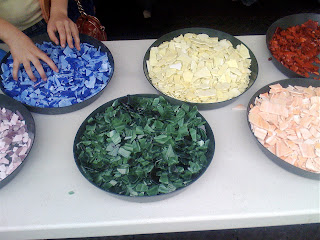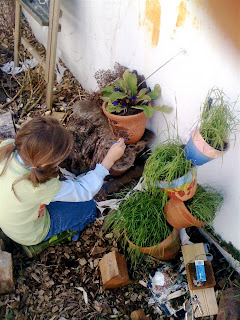Juliet over at I'm A Teacher, Get Me OUTSIDE Here! has a post up about the ridiculous lengths some schools go in the name of keeping children "safe": teeth-grindingly ridiculous things like banning blindfolds, string, and dirt! Things we play with at Woodland Park every day.
It's a product of worst case scenario thinking run amuck. Naturally, we should be prepared for the off-chance that something really bad will happen (e.g., living in an earthquake prone area we have plans and supplies on hand in case a big one hits) but we can't live in fear of it happening. Can a child hurt himself with a piece of string? If I let my brain run freely through my nightmares, I can come up with a few horrific possibilities, but realistically it ain't gonna happen. If I let my fevered imagination go, I can think of far more terrifying scenarios involving children being allowed to ride in a car, or walk out the front door, or get out of bed.
Life is an inherently risky proposition. Yesterday, I heard a spokesperson of some sort talking on the radio about his industry. He made the comment, "No one has ever died from being over-protective." Really? People are killed and maimed every day because of their lack of experience in assessing risk. They do stupid things because they don't know any better and the price nature often makes humans pay for ignorance is pain.
In addition, I fear that the instinct to be over-protective too often results in environments that give children (and adults) such a false sense of security that they behave in ways about which they would think twice if we didn't "round every corner and eliminate every sharp object, every pokey bit in the world." For instance I consider our large, soft foam blocks to be the most dangerous single item with which we play at school, not because they are inherently dangerous, but because both children and adults perceive that they are harmless and therefore play with a kind of recklessness that hard wooden blocks simply don't encourage.
I tell my parent assistant teachers that the primary way we keep the children safe in preschool is to use our own eyes, ears, and hands -- you know, pay attention to what's going on. I also tell them that our job isn't to prevent children from being hurt, but to prevent them from being seriously hurt. I'm firmly convinced that every pinched finger we help a child avoid today is just a pinched finger -- or worse -- that we push off into the future. Naturally we would step in if a 2-year-old was balling up a length of string and shoving it into her mouth or wrapping it tightly around a friend's neck (two things that I've never seen an actual child do with string, although I can fearfully imagine a child doing it), but do we forbid that child the opportunity to wear the necklace she has carefully made from it on the outside chance that she will somehow manage to strangle herself? She is infinitely more likely to die in a car accident on the way home, yet we don't think twice about putting her in that car.
Yesterday, I found myself in the midst of Seattle's annual Folklife Festival at Seattle Center where I found the Center For Wooden Boats tent jam-packed with children and their parents taking their lives into their own hands by using hammers, nails, and drills.
They were making their own wooden boats using real tools at this
huge public event: all that intense concentration right there
in the midst of clowns, stilt walkers, and music. Very impressive.
And later, at the International Fountain, I saw everyone from toddlers to grandparents risking their lives playing on its slippery concrete slopes on a cool, rainy day:
Seriously, it was so slippery that those boys are sliding all the way down as
if on skateboards.
We are designed by our maker to take risks. Just try to stop us!



















































